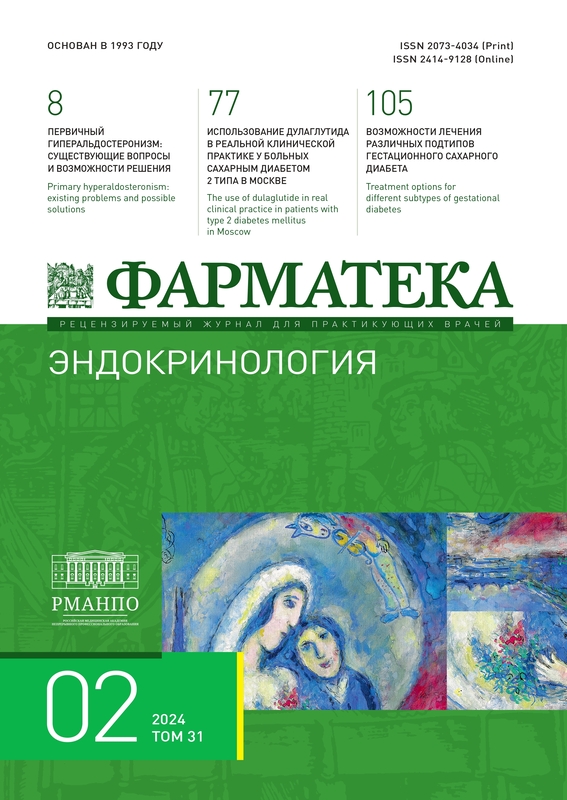Treatment options for different subtypes of gestational diabetes
- 作者: Davidenko I.Y.1, Volkova N.I.1, Degtyareva Y.S.1
-
隶属关系:
- Rostov State Medical University
- 期: 卷 31, 编号 2 (2024)
- 页面: 105-110
- 栏目: Original articles
- URL: https://journals.eco-vector.com/2073-4034/article/view/632443
- DOI: https://doi.org/10.18565/pharmateca.2024.2.105-110
- ID: 632443
如何引用文章
详细
Background. Modern methods of treating gestational diabetes (GD) are aimed at preventing excessive fetal growth and the development of complications through lifestyle modification and diet therapy, and, if ineffective, insulin therapy. Taking into account the research data of recent years, different subtypes of GD based on the predominance of the pathological mechanism – β-cell defect, insulin resistance (IR) or a combination of these factors – are identified. Determining the subtype of GD can be of extreme clinical importance, since the choice of treatment tactics for patients and, as a result, their achievement of target blood glucose values may depend on the mechanisms underlying the pathogenesis of carbohydrate metabolism disorders.
Objective. Evaluation of the effectiveness of modern treatment methods depending on the GD subtype.
Methods. 130 pregnant women without a history of carbohydrate metabolism disorders were examined (an oral glucose tolerance test with 75 g of glucose and an additional determination of fasting insulin during the test). The subjects were divided based on the examination results, as well as calculation of the Matsuda index: group I – 45 pregnant women with GD and β-cell dysfunction, group II – 43 pregnant women with GD and IR. Additionally, all study participants were surveyed using a specially developed questionnaire. Statistical analysis was carried out using comparative analysis. Data are presented as medians and interquartile ranges of quantitative indicators in groups. Data were considered statistically significant at p<0.05.
Results. All patients achieved target glycemic values. In the GD group I, 29 (64.4%) patients received only non-drug therapy, while 16 (35.6%) used diet therapy in combination with insulin administration. In the GD group II, 16 (37.2%) patients received only non-drug therapy, 27 (62.8%) pregnant women used diet therapy in combination with insulin therapy. In the GD II group, patients were significantly less likely to use whole grain products in their diet compared to pregnant women in the GD group and β-cell defect: 6 (14%) patients versus 12 (27%), p=0.03, more often consumed foods with added sugar: 14 (33%) versus 4 (9%), p=0.04 in the GD group I.
Conclusion. Patients with GD and β-cell dysfunction more often achieve GD compensation with non-drug treatment, while patients with GD and IR more often require insulin therapy.
全文:
作者简介
I. Davidenko
Rostov State Medical University
编辑信件的主要联系方式.
Email: Davidenko.iu@gmail.com
ORCID iD: 0000-0002-8690-681X
Cand. Sci. (Med.), Associate Professor at the Department of Internal Diseases № 3
俄罗斯联邦, Rostov-on-DonN. Volkova
Rostov State Medical University
Email: Davidenko.iu@gmail.com
ORCID iD: 0000-0003-4874-7835
俄罗斯联邦, Rostov-on-Don
Yu. Degtyareva
Rostov State Medical University
Email: Davidenko.iu@gmail.com
ORCID iD: 0000-0001-5838-4383
俄罗斯联邦, Rostov-on-Don
参考
- Care and prevention. 2021. Gestational diabetes. [online] Idf.org. Available at: https://www.idf.org/our-activities/care-prevention/gdm [Accessed 20 August 2021].
- Алгоритмы специализированной медицинской помощи больным сахарным диабетом. Под ред. И.И. Дедова, М.В. Шестаковой, А.Ю. Майорова. 10-й выпуск. М., 2021. [Algorithms for specialized medical care for patients with diabetes. Eds. I.I. Dedova., M.V. Shestakova, A.Yu. Mayorova (10th edition). M., 2021. (In Russ.)]. doi: 10.14341/DM12802.
- Uptodate.com. 2024. UpToDate. [on-line] Available at: https://www.uptodate.com/contents/gestational-diabetes-mellitus-obstetric-issues-and-management [Accessed 20 February 2024].
- Гестационный сахарный диабет. Диагностика, лечение, акушерская тактика, послеродовое наблюдение. Клинические рекомендации, 2020.
- Волкова Н.И., Давиденко И.Ю., Дегтярева Ю.С. Гестационный сахарный диабет. Акушерство и гинекология. 2021;9:174–9. [Volkova N.I., Davidenko I.Yu., Degtyareva Yu.S. Gestational diabetes mellitus. Akusherstvo i ginekologiya=Obstetrics and Gynecology. 2021;9:174–9 (In Russ.)]. doi: 10.18565/aig.2021.9.174-179.
- Powe C., Allard C., Battista M., et al2016. Heterogeneous Contribution of Insulin Sensitivity and Secretion Defects to Gestational Diabetes Mellitus: Table 1. Diab Care. 2016;39(6): 1052–5.
- Liu Y., Hou W., Meng X., et al. Heterogeneity of insulin resistance and beta cell dysfunction in gestational diabetes mellitus: a prospective cohort study of perinatal outcomes. J Translat Med. 2018;16(1).
- Feghali M., Atlass J., Ribar E., et al. 82: Subtypes of gestational diabetes mellitus based on mechanisms of hyperglycemia. Am J Obstetr Gynecol. 2019;220(1):S66.
- Benhalima K., Van Crombrugge P., Moyson C., et al. Characteristics and pregnancy outcomes across gestational diabetes mellitus subtypes based on insulin resistance. Diabetol. 2019;62(11): 2118–28.
- Майоров А.Ю., Урбанова К.А., Галстян Г.Р. Методы количественной оценки инсулинорезистентности. Ожирение и метаболизм. 2009;2:19–23. [Mayorov A.Y., Urbanova K.A., Galstyan G.R. Methods for guantificative assessment of insulin resistance. Ozhirenie i metabolizm=Obes Metab. 2009;6(2):19–23 (In Russ.)]. doi: 10.14341/2071-8713-5313.
- Волкова Н.И., Давиденко И.Ю., Сорокина Ю.А. и др. Методы оценки инсулинорезистентности при гестационном сахарном диабете. Медицинский вестник Юга России. 2022;13(1):5–12. [Volkova N.I., Davidenko I.Yu., Sorokina Yu.A., et al. Methods for assessing insulin resistance in gestational diabetes mellitus. Med Herald of the South of Russia. 2022;13(1):5–12. (In Russ.)]. doi: 10.21886/2219-8075-2022-13-1-5-12.
- Gutch M., Kumar S., Razi S.M., et al. Assessment of insulin sensitivity/resistance. Indian J Endocrinol Metab. 2015;19(1):160–4. doi: 10.4103/2230-8210.146874.
- Wallace T.M., Levy J.C., Matthews D.R. Use and abuse of HOMA modeling. Diab Care. 2004;27:1487–95.
补充文件








